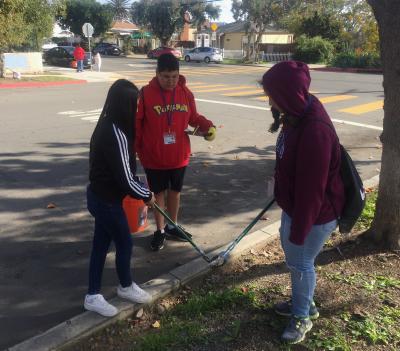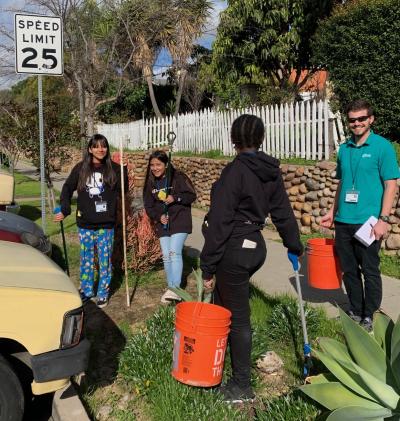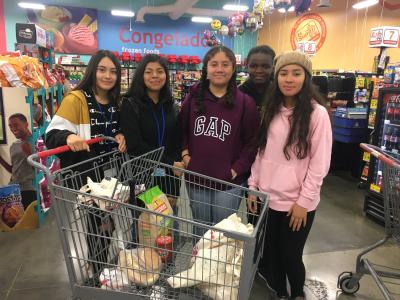Breadcrumb
Taking it to the streets: Tackling urban trash pollution through education & action
While there are trash monitoring protocols for waterways and shorelines, less attention is paid to plans for addressing trash along urban streets. Marine debris education, activities and messaging are predominantly geared toward coastal areas, leaving out urban areas.
California Sea Grant, in partnership with the Ocean Discovery Institute and the National Oceanic and Atmospheric Administration Marine Debris Program, developed the Urban Trash Education & Community Science Toolkit to help. It includes a standardized street trash monitoring protocol and hands-on Trash Troop science education activities. The monitoring protocols are intended for community scientists of all ages and backgrounds, and the educational activities are aimed at students grades 8 through 12 for use in classrooms, clubs, scouts, camps, after-school programs and more.
A TRASH POLLUTION Educational & Community Science Monitoring Toolkit

The goal of this toolkit is to increase science literacy and improve understanding of the issues surrounding trash pollution to empower students and communities to become a part of the solution.
The street trash monitoring protocol is a community science tool that allows community members and students to collect data on the types and amounts of trash items that travel from consumers to city streets and into waterways, as well as the neighborhood features that may influence trash flows (e.g., types of land use or landscaping). Community scientists can use the protocol to answer questions of interest about trash pollution in their area, including:
- What types and amounts of trash ‘escape’ on trash collection day?
- How effective is street sweeping in reducing street trash accumulations?
- What are the most common types of trash found near parks after holiday weekends?
- What types of landscaping best trap common trash items?
- Where are the hotspots of trash accumulation that can be prioritized during clean-up events?
The Trash Troop Activities can be used to guide students through lessons underlining the problem and the effects of trash pollution, and engage students to think critically about effective solutions. Each activity can be done individually and one is not needed to understand the next. They can also be accompanied by the street trash monitoring protocol. These activities vary in length, preparation, and involvement, and are intended to be adaptable for use in both formal and informal learning environments. To make things easier for facilitators, we have incorporated suggested standards alignment, potential connections across activities and action projects beyond the classroom. Additional resources -- full unit plans, helpful videos and other marine debris curricula -- are available below.
Table of Contents
- The Urban Trash Monitoring Protocol
- Urban Trash Troop Activities
- Related Marine Debris Videos
- Additional Marine Debris Educational Resources
The Urban Trash Educational Toolkit contains open source and ‘living’ resources and we welcome feedback from users to help improve the products using this Feedback Form.
Questions or comments not covered by the form? Please contact us! Theresa Talley (tstalley@ucsd.edu) or Tanya Torres (tatorres@ucsd.edu).
The Urban Trash Monitoring Protocol
Collect data while you clean up the neighborhood! The standardized protocols (PDF), which include instructions and datasheets, can be used with your group to collect and monitor trash along the streets. The protocol offers a flexible, tiered approach to trash monitoring, allowing community scientists to choose the types and amounts of data they collect based on their interests, goals, abilities and time.
The protocol includes 1) a field-based assessment of trash and other neighborhood features that may contribute to trash levels, 2) a web-based assessment of contributing features, and 3) an in-depth quantitative assessment of the types and amounts of trash collected.
Download the datasheets for each assessment here:
- Field site assessment sheet (PDF): Assess each block for features that may influence amounts and types of trash, including the slope of the street, ground cover, land uses, and numbers of parked cars and waste bins.
- Web site assessment sheet (PDF): Use Google Earth to record data about the blocks you assess, including calculating geographic coordinates and the lengths of the various land-use types.
- Quantitative trash sheet (PDF): Record the types and amounts of trash collected with the level of detail increasing with each of four tiers of information.
Urban Trash Troop Activities
The Problem
Watershed Flows – Build a city, trash it up and visualize how trash and contaminants move through a watershed after precipitation events.
Remote Sensing with Google Earth –Become familiar with Google Earth while learning how trash makes its way from our streets to nearby waterways.
Trash Can Audit – Assess the contents of your trash to see the types and amounts of waste we generate, and how much is misplaced, which prevents proper disposal.
The Effects

Sink or Float? – explore the properties of plastic trash and see how they behave in the marine environment.
Urban Litter Scavenger Hunt – see the effects of trash on an area by trying to find all of the items on this scavenger hunt.
Urban Trash Monitoring – understand where, how much and what kinds of debris are present in your environment using this activity that introduces the Urban Trash Monitoring Protocol.
The Solutions

From Trash to Treasure – upcycle plastic bags that would thrown out while creating art and learn about the properties of materials.
Plastic-free Lunch – get the chance to make real-life choices and practice making plastic-free purchases for lunch.
Start a Movement! – motivate people in your community to help solve the marine debris issue by creating your own behavior change campaign.
Upcycled Arts & Crafts – repurpose common trash materials through upcycling ‘waste’ plastics into arts and crafts.
The Final Straw (PDF) – Take a stand against plastic by making a pledge to change one aspect of daily life that uses a lot of plastic.
Building a Science Identity
Career Quiz (PDF) – Explore possible future careers by taking this RIASEC quiz.
Who Are Scientists? – Gauge the changes in young people's perceptions of scientists by having them work in groups to depict a “typical” scientist.
What Is Science? – Discuss and illustrate the basics of the scientific process to establish a baseline of understanding through an experiment.
Science Stems – Encourage reflection and assess learning and changes in perception by completing these sentence stems.
Related Marine Debris Videos
- A Plastic Wave - A Documentary Film on Plastic Pollution (Youtube)
- Filtering a Plastic Ocean (Audpop)
- Gyre: Creating Art from a Plastic Ocean
- Inside the Lab That Could Solve the World's Plastics Problem (Bloomberg QuickTake/Youtube)
- Investigating Plastic Pollution - The Basics (Algalita/Youtube)
- Kenyan woman finds a way to recycle plastic waste into bricks that are stronger than concrete (Yahoo News)
- The Evolution of Plastic (Chesapeake Quarterly ArcGIS story map)
- The Story of Plastic: How Plastic Production Pollutes Small Towns (The Story of Stuff Project/Youtube)
- The Story of Plastic: The Plastic Bag Diet (The Story of Stuff Project/Youtube)
- The Story of Plastic: Where Your Recycled Plastic Ends Up (The Story of Stuff Project/Youtube)
- What Really Happens to the Plastic You Throw Away - Emma Bryce (TED-Ed/Youtube)
- #CleanSeas Break-Up PSA: "It's not me, it's you." (UN Environment Programme/Youtube)
Additional Marine Debris Curriculum
- National Marine Sanctuaries: Zero Waste Week - Ocean Guardians Schools
- NOAA Marine Debris Program: An Educator’s Guide to Marine Debris
- NOAA Marine Debris Program: Educator’s Guide to Marine Debris in the Southeast and Gulf of Mexico
- NOAA Marine Debris Program: Talking Trash & Taking Action
- NOAA Marine Debris Program: TRASH TALK - Where does marine debris come from?
- NOAA Marine Debris Program: Turning the Tide on Trash
- NOAA Marine Debris Program: USVI Marine Debris Curriculum
- Washed Ashore - Art to Save the Sea
- Winged Ambassadors – Ocean Literacy through the Eyes of Albatross
- California Seafood Profiles
- Aquaculture in California
- Discover California Commercial Fisheries
- Seaweed Aquaculture
- Kelp
- Coastal Hazards & Resilience
- Marine Protected Areas
- Red Tides in California
- King Tides
- Rip current safety
- FAQ: California’s Marine Heatwaves
- FAQ: Droughts & California’s Coastal Regions
- Estuaries: Connecting Land to Ocean
- Street Trash Monitoring Protocols and Educational Curriculum
- Safely Viewing Marine Mammals
- Grunion: bridging land and sea
- Delta Smelt
- Recursos en Español